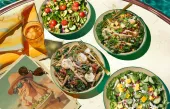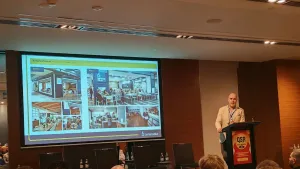Six marketing tips to save your quick service restaurant brand post-COVID-19
By Christina MurrellWith store reopenings imminent, most QSR brands will prepare for operational readiness, including adjusting processes to expected government requirements relating to customer and staff safety and hygiene.
But many may not think much about marketing – efforts to place their brand in the spotlight during a time when their brand needs all the attention it can get. It doesn’t really matter if your store has already opened or not. It doesn’t matter how strong and established your brand was prior to the coronavirus crisis. At an individual store level, that store is vulnerable and is at risk of permanent closure.
Store re-opening is an opportunity to reboot your store to give it the attention and energy it needs before it is really too late.
Marketing Tip # 1 – First 90 Days Promotional Calendar
A 90 Days Promotional Calendar will help you to stay focus and to ensure that your customers get the message frequency they need to maintain your brand in mind. Your
calendar must address three core customer types:
- New Customers – With work from home expected to remain in place for many corporate businesses, less customers are expected to be around. Extreme efforts must be made to get new customers from a reduced potential pool through your door. Identify groups of people that are around such as construction workers, that group of professional workers from Price Waterhouse Coopers in your building. What offer can you make that they cannot refuse? Think about how you will get that offer to them. Develop a flyer and approach the foreman of the construction site? You must go the extra mile to reach them.
- Walk-in Customers – For those customers who do come into your store, how will you keep them interested? What bundled offers can you offer? Limited time specials? What promotional material do you need to get people’s attention as they walk pass or into your store? These are in-store promotions and separate to your standard menu.
- Loyal Customers – customers on your Loyalty Program must not be forgotten. What efforts should you make to remind and reward customers on your Program? What limited time specials can you offer them? What experiences you can give? Perhaps gifts you can provide? How will you get the offer to them?
Marketing Tip # 2 - Store Relaunch Campaign
A store relaunch campaign will give your store the customer attention and revived staff energy to reboot it. This must be included in your First 90 Days Promotional Calendar. Without a relaunch campaign, the message of your store reopening may be lost. Your big day campaign must have the following elements:
- Relaunch Day Offer – give customers reasons to come to your event.
- Return Offer – for people who do come, what should you offer to tempt them back again?
- Use your own channels to get reach and to generate awareness - create content on your website, Google My Business, Loyalty App, social media, handout flyers in front of your store and to existing customers if your store is already open.
- Negotiate with the centre management or building management to provide complementary communications support for your relaunch – through their own channels such as their website, social media, database, digital posters and signage.
- If you have Collaborators, negotiate with them to support your campaign through their community channels.
- Generate publicity if you can think up of a good hook – a story that the media likes.
- If you have budget, pay to get reach and awareness – street promotions and flyer distribution, street sampling, Facebook ads.
- Dress up the store on D-Day. Visually make it obvious that today is the big relaunch day. From experience, 40-60% of customers who attend your event saw the day’s commotion and spontaneously decided to join in. Include things like banners, posters, digital screens and posters, party bags, concierge with balloons etc. How can you communicate the changes to your store to the people who come? Give an extra incentive to sign up on the Loyalty Program.
- Put on a show on D-Day - ensure that everyone understand their roles and responsibilities to smoothly run the event. You must put on a great show to ensure your guests have a great customer experience: Buying Experience, Product Experience and Care Experience.
Marketing Tip #3 – Revise Menu Mix
When stores have fully reopened, many office workers will still be working from home. Experts predict that businesses will structure their workforce on a rotational basis between
teams working at the office and from home. Therefore, the volume of customers on any given day will be much less than pre-coronavirus time.
For casual dining QSR brands, consumer sentiment towards crowded places will continue to be a big threat for a long time. It will take time to rebuild consumer trust that everything is
safe again. Brands that have an older customer base will be more affected. According to a US study recently released by Datassential, showed that 81% of respondents who said they will definitely avoid eating out [when doors re-open] are Baby Boomers.
To top it off, experts are predicting that Australia is heading into a recession. A recession will change consumer spending including forgoing expensive items for small luxury items like
treats and chocolate, bringing lunch to work and more cooking at home. Be prepared and respond by revising your menu mix. Consider:
- Introducing food that travel better with higher ticket price for food delivery. Introduce meals for specific groups of people such as the older market. Consider suitable packaging. Introduce Grab and Go meals for lunch and dinner for Pickup.
- Creating meals for specific groups of people who are still working nearby. Introduce bulk meal prices. Introduce pre-purchase lunch programs such as a Weekly Lunch Pass.
- Simplifying meals that require fewer staff to prepare. The fewer staff that is rostered on may be required to do more than before. Consider staff training and up-skilling requirements.
- Creating meal kits and meal kit programs as an alternative for customers from buying grocery items and cooking at home. Introduce affordable luxury items like treats and desserts as a bundled meal offering. Introduce half price days on usually quiet days. Changes to your menu should be communicated as a promotion and added to your Promotional Calendar.
Marketing Tip # 4 – Focus on Pickup
If offering delivery services is not viable for your business, then you must focus your efforts on Pickup. You should consider the following to make Pickup a real customer proposition:
- Pickup Station – ideally modify your store to have a specific Pickup area by design. Consider customer the flow whether it is a drive-by or a walk-by area. Ideally, provide access from outside so that customers can avoid entering your premises all together. It must have clear signage. If renovation is not possible, then you should have a clear and dedicated area inside, close to the front with easy access for customers to come in and out.
- Curb side pickup – more popular in the US, curb side pickup is probably more suitable for locations where parking is problematic. With this option, a clear area and clear communication is required so customers know where to pull over and whether they will be notified by text.
- Incentivise for Pickup – provide an attractive Pickup incentive such as discounts and freebees for Pickup orders.
- Customer Experience – the real Pickup proposition is providing an amazing food Pickup customer experience. Explore ways to surprise and delight the customer at this interaction. A staff on roller blades dancing along catchy tunes from speakers hidden on his body delivering your food on the curb side, is an experience to remember!
- Promotion – promote, promote and promote why food Pickup at your store is awesome on every communications channel you own such as your website, social media, in-store, e-newseltter and consistently too. Any changes to Pickup should be communicated as a promotion and added to your Promotional Calendar.
Marketing Tip # 5 - Contactless Ordering & Payment
It will take a while for consumers to believe that everything is safe again. They will remain cautious about touching your furniture, fittings and equipment including kiosks and EPTPOS
machines. You should consider going contactless as a long-term strategy. These are your choices:
- Contactless ordering and payment
- Mobile App – usually via a Loyalty platform where customers can Order Ahead and Pay.
- Web App – this is simply adding an e-commerce function to your existing website. Communicate to customers to add your website to the Home Screen of their mobile phones. This acts as a short cut to your website.
- Over the phone – consider going old fashion and accept over the phone orders and payments.
- Chatbots – especially on Facebook where you can program a chatbot to take customer orders and transact payment.
- Contactless payment
- Payment – consumers are familiar with Paywave (‘tap’) and more are using Apple Pay to pay for goods in-store. Many Loyalty Apps also have a Pay In-Store feature, paying through their own phone at the counter. Any changes to the way you accept orders and payments should be communicated as a promotion and added to your Promotional Calendar.
Marketing Tip #6 – Alternative Delivery Services
Demand for food delivery has skyrocketed and this demand is unlikely going to change. The cost of offering food delivery has always been a barrier. It’s either paying commissions to 3rd party aggregate services such as UberEats and Deliveroo, or paying for your own branded delivery service. There are a few other options to think about:
- Collaborated delivery services on demand – team up with other brands and share the cost of providing a joint delivery service.
- Scheduled meal kit delivery – if you offer bulk meal kits (food that does not have to be eaten straight away) you can schedule your delivery run to a few times a week as oppose to on demand.
These marketing tips are really mission critical for the very changed market conditions that will become the norm. A concentrated marketing effort in the next six months may just as well become the differentiating factor between individual stores that truly survive the crisis.




























